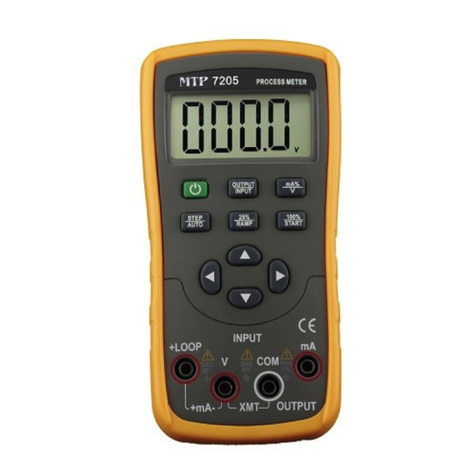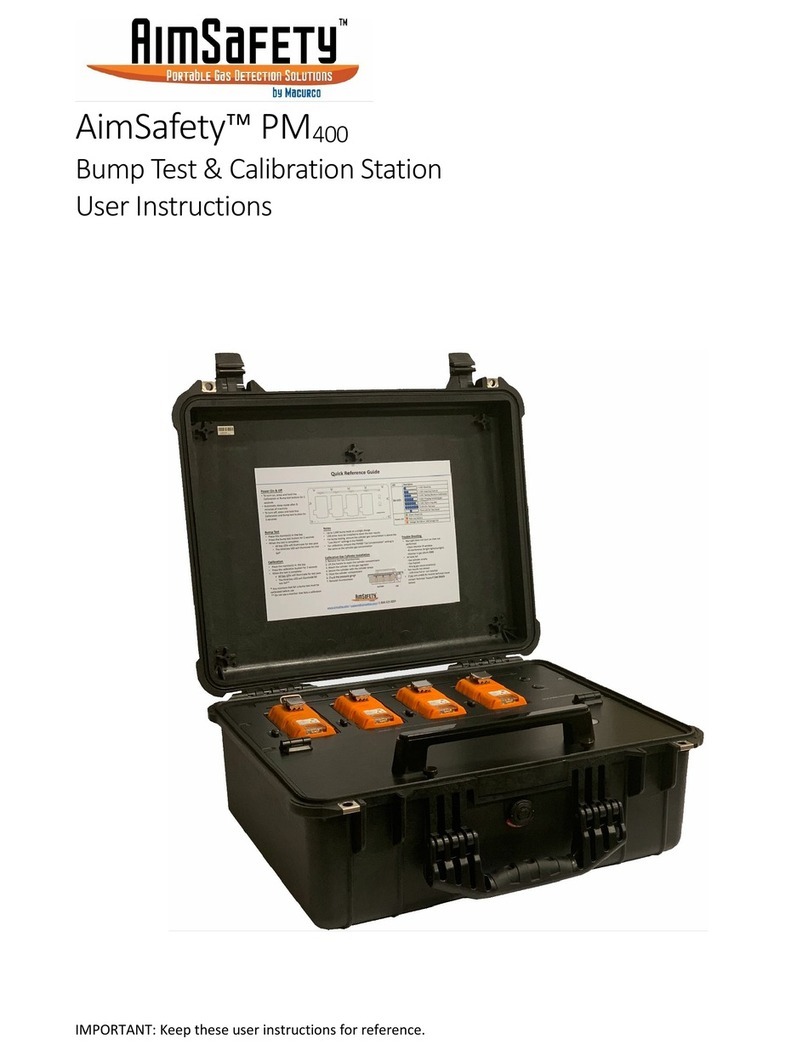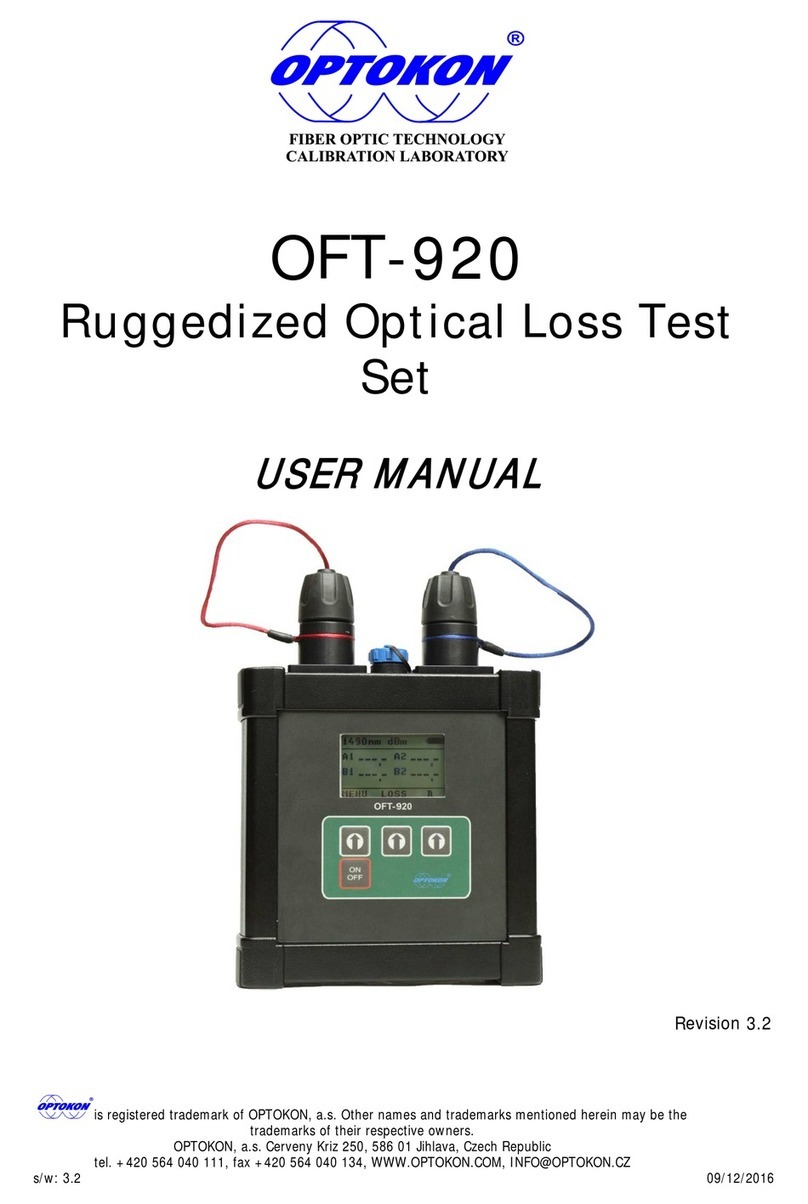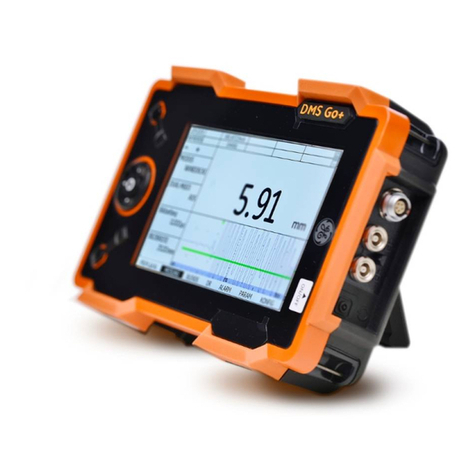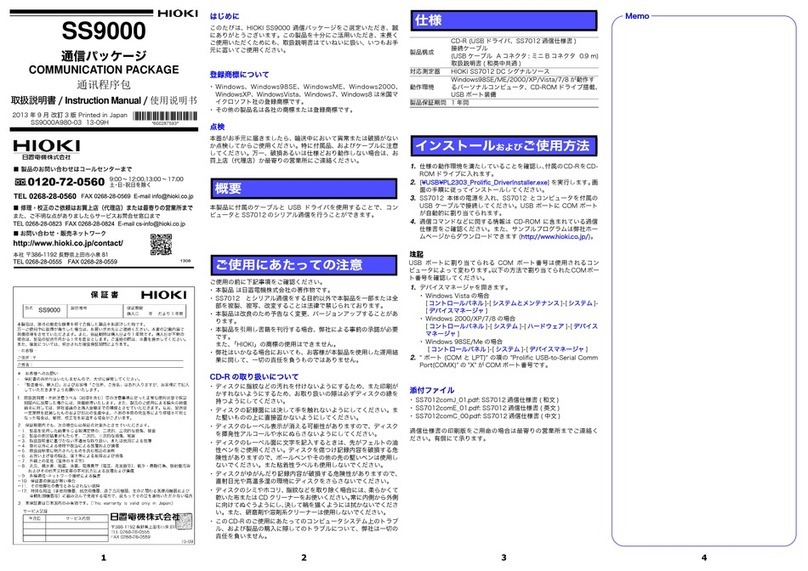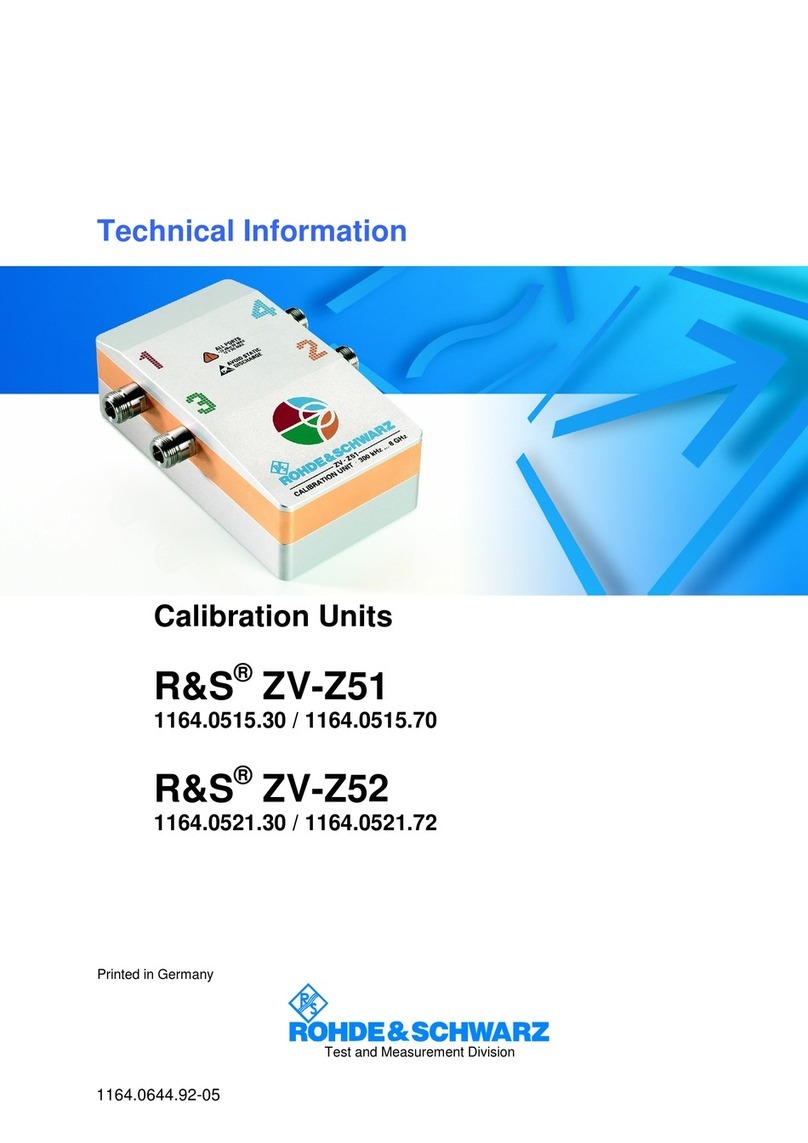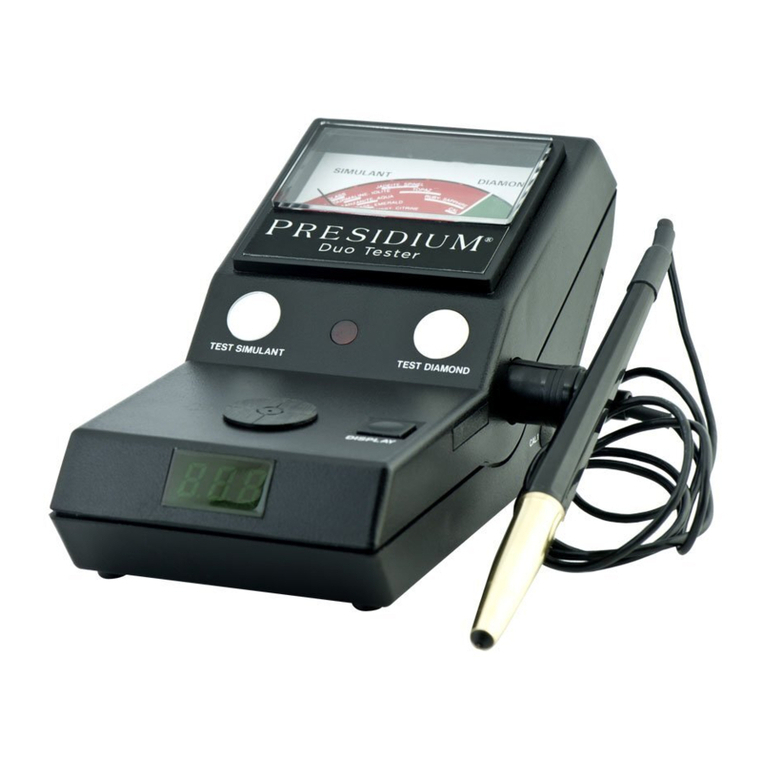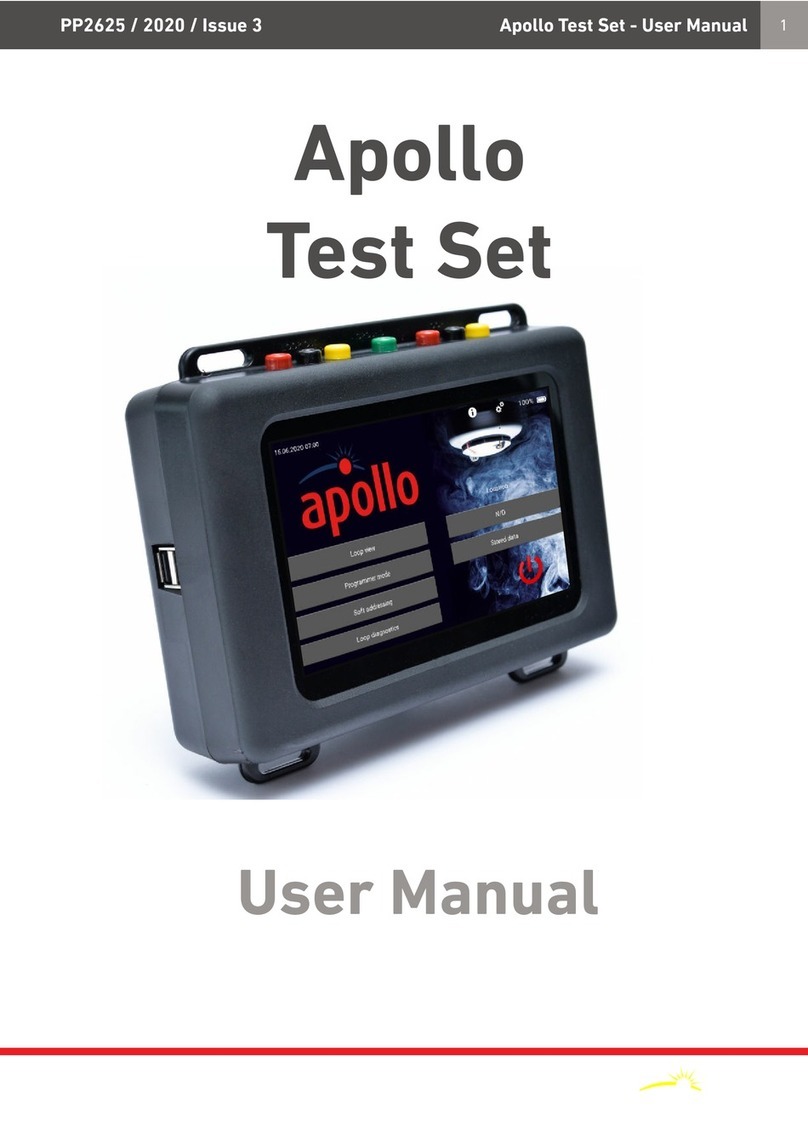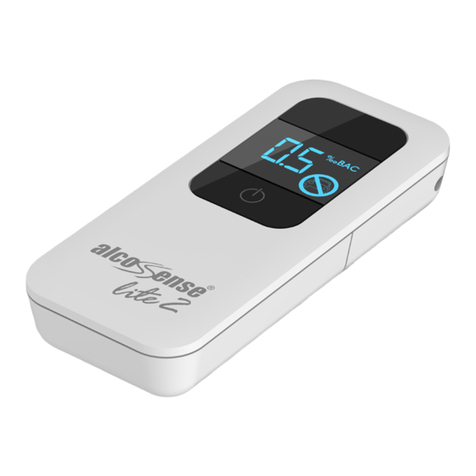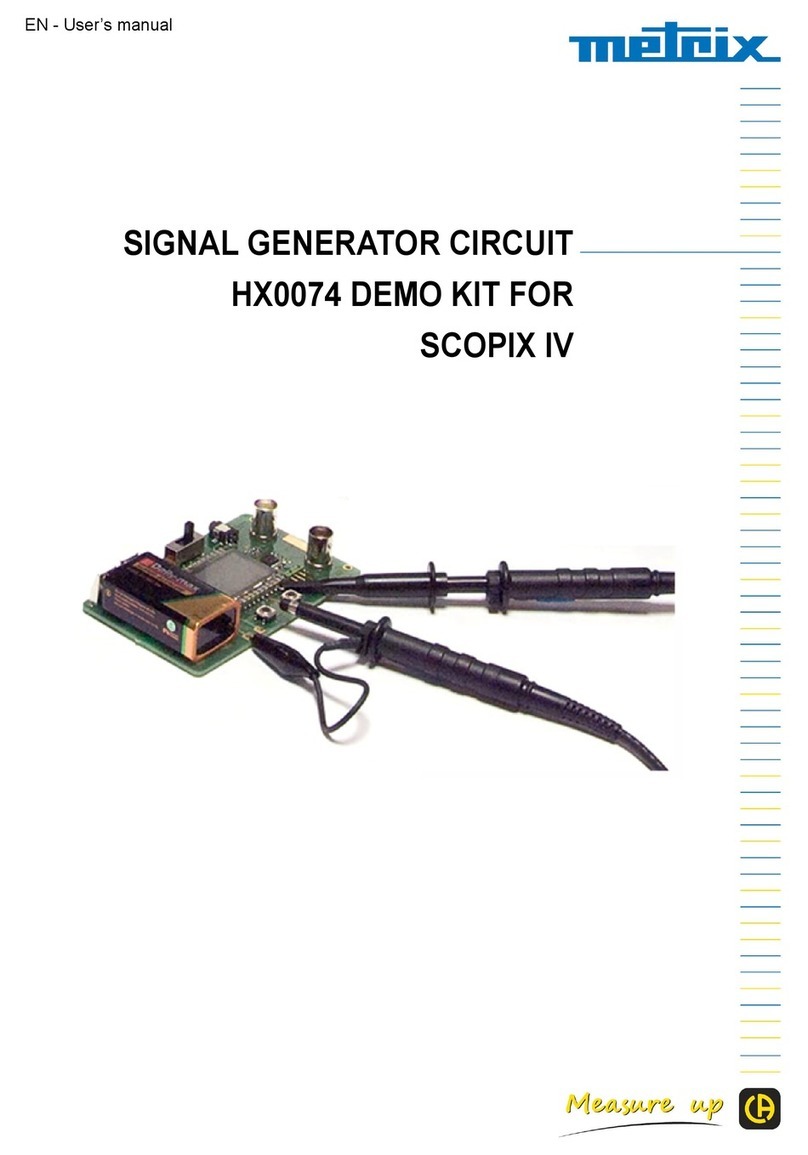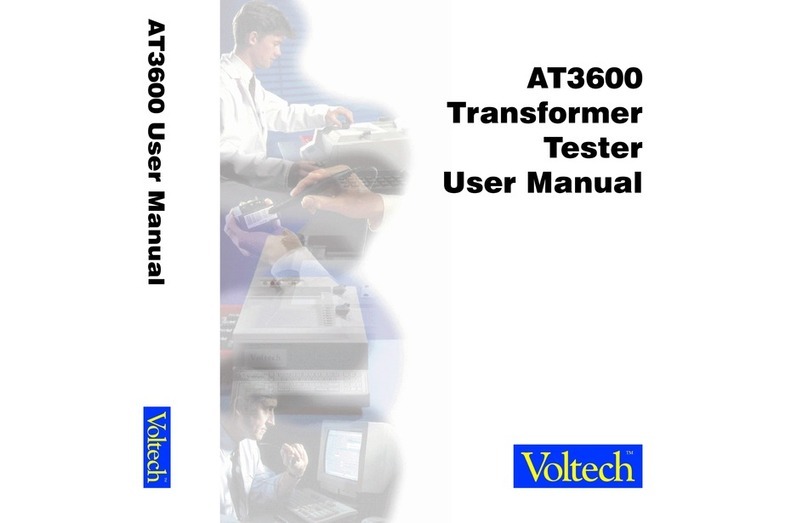Probewell MT-1/WT3 User manual

MT-1/WT3
USER GUIDE
HIGH ACCURACY THREE-PHASE
WIRELESS WATTHOUR METER TESTER

MT-1/WT3
User Guide
Version 2.3 –March 2021
IT IS ESSENTIAL THAT OPERATORS THOROUGHLY READ THIS INSTRUCTION
MANUAL BEFORE PUTTING THIS PRODUCT INTO SERVICE.
© Copyright 2021 by Probewell Lab Inc. Printed in Canada.
All rights reserved, including those to reproduce this manual or parts thereof, in any form
without the express written permission of Probewell Lab Inc.

Probewell Lab Inc.
Page •2
Limited Warranty
Your MT-1/WT3 comes with a two-year hardware warranty. Probewell Lab Inc.
(Probewell) warrants this MT-1/WT3 against defects in material and workmanship
for a period of two (2) years from the date of purchase from Probewell. This warranty
applies only to the original purchaser of the MT-1/WT3 and is not transferable.
All accessories come with a two-year hardware warranty. Probewell warrants all
accessories against defects in material and workmanship for a period of two (2) years
from the date of purchase from Probewell. This warranty applies only to the original
purchaser and is not transferable.
This warranty does not cover any damage caused neither by negligence, non-
authorized modifications, or parts installed without prior written permission from
Probewell.
This warranty does not apply if the product has been damaged by accident, abuse,
misuse, or misapplication, nor as a result of service to the product by anyone other
than Probewell.
PROBEWELL IS NOT RESPONSIBLE FOR ANY LOST PROFITS, LOST SAVINGS OR OTHER
INCIDENTAL OR CONSEQUENTIAL DAMAGES ARISING OUT OF THE USE OF OR THE
INABILITY TO USE THIS PRODUCT. THIS INCLUDES DAMAGE TO PROPERTY AND
DAMAGES FOR PERSONAL INJURY. THIS WARRANTY IS IN LIEU OF ALL OTHER
WARRANTIES, INCLUDING IMPLIED WARRANTIES OF MERCHANTABILITY AND
FITNESS FOR A PARTICULAR PURPOSE.
Disclaimer
Probewell Lab Inc., (Probewell) reserves the right to make changes to this document
and to the products it describes without notice. Probewell shall not be liable for
technical or editorial errors or omissions made herein; nor for incidental or
consequential damages resulting from the furnishing, performance, or use of this
material.
Features and specifications are subject to change without notice.

MT-1/WT3 User Guide
Page • 3
Table of Contents
Introduction .............................................................................................................. 7
MT-1/WT3 Overview ............................................................................................. 7
Description................................................................................................................ 9
MT-1/WT3 Socket.................................................................................................. 9
Front/Rear View of the Socket ........................................................................ 10
Side View of the Socket ................................................................................... 11
Theory of Operation ............................................................................................ 13
Meter Testing .................................................................................................. 15
Accessories .......................................................................................................... 17
Metercam ........................................................................................................ 17
Optical Pickup.................................................................................................. 18
Meter Adapters ............................................................................................... 19
Operation................................................................................................................ 21
Summary.............................................................................................................. 22
Installing the Socket............................................................................................. 23
Connecting to the MT-1/WT3.............................................................................. 25
Running the Application ...................................................................................... 25
Available .............................................................................................................. 26
Tests .................................................................................................................... 26
Test Examples...................................................................................................... 27
Example 1: Quick Test - Solid-State 9S Meter.................................................. 28
Example 2: Custom Test - Solid-State 9S Meter .............................................. 30
Example 3: Tracking Test –12S(N) Meter........................................................ 31
Example 4: Custom Test –2S Electromechanical Meter.................................. 33
Example 5: kW Demand Test –Electromechanical 14S Meter ........................ 35
Example 6: Full Test –Solid-State 8S Fitzall Meter .......................................... 37
Example 7: Four-Quadrant (Wh) Test –Solid-State 9S Meter ......................... 39
Example 8: Meter Tested in the Meter Shop................................................... 41
Appendix A
Specifications........................................................................................................... 43
Appendix B
Compatible Meter Forms......................................................................................... 47
Form 1S................................................................................................................ 48
Form 2S................................................................................................................ 49
Form 3S................................................................................................................ 50
Form 4S................................................................................................................ 51
Form 5S, 35S & 45S Fitzalltm (3 2CT).................................................................. 52
Form 5S, 35S & 45S Fitzalltm (3 2CT 2PT) ........................................................... 53
Form 5S, 35S & 45S Fitzalltm (N 2CT).................................................................... 54
Form 5S, 35S & 45S Fitzalltm (N 2CT 2PT) ............................................................. 55
Form 5S, 35S & 45S Fitzalltm (Y 3CT)..................................................................... 56
Form 5S, 35S & 45S Fitzalltm (Y 3CT 2PT).............................................................. 57
Form 5S, 35S & 45S Fitzalltm (Y 2CT)..................................................................... 58

Probewell Lab Inc.
Page •4
Form 5S, 35S & 45S Fitzalltm (Y 3CT 2PT).............................................................. 59
Form 5S, 35S & 45S Fitzalltm (4 3CT 2PT) ........................................................... 60
Form 5S, 35S & 45S Fitzalltm (4 3CT).................................................................. 61
Form 6S (36S, 46S) (Y 3CT)................................................................................... 62
Form 6S (36S, 46S) (Y 3CT 2PT)............................................................................ 63
Form 6S (36S, 46S) Fitzalltm (Y 3CT)...................................................................... 64
Form 6S (36S, 46S) Fitzalltm (Y 3CT 2PT)............................................................... 65
Form 8S (4 3CT)................................................................................................. 66
Form 9S (4 3CT)................................................................................................ 67
Form 9S (Y 3CT) ................................................................................................... 68
Form 9S (Y 3CT 3PT)............................................................................................. 69
Form 12S (25S) (3N)............................................................................................. 70
Form 12S (25S) (3)............................................................................................. 71
Form 14S (4Y)s..................................................................................................... 72
Form 15S (4)...................................................................................................... 73
Form 16S (4Y) ...................................................................................................... 74
Appendix C
Form Configurations................................................................................................ 75
Appendix D
Troubleshooting ...................................................................................................... 77
Appendix E
Customer Service..................................................................................................... 79
Appendix G
Recommendations................................................................................................... 81

MT-1/WT3 User Guide
Page • 5
List of Abbreviations
Abbreviation
Complete term
A
Ampere
Amp
Ampere
AC
Alternating current
AP
Access point
ATK
Accuracy Testing Kit
CFM
Cubic feet per minute
CL
Class
CSV
Comma-separated values
CT
Current transformer
DSP
Digital signal processor
HL
High load (full load)
Kh
Watthour constant. The number of watthours represented by
one revolution of the disk. Also called disk constant.
Kt
Test constant. For electronic (no disk) meters, the amount of
energy represented by each calibrated pulse of the LED.
kW
Kilowatt
Lb.
Pound
LL
Light load
NIST
National Institute of Standards and Technology
PF
Power factor
PPI
Pore per inch
Rev
Revolution, number of revolutions
RMS
Root mean square
TA
Test ampere
THD
Total harmonic distortion
V
Volt
VA
Volt-ampere
VAC
Volt(s) of alternating current
VARh
VARhour (volt-ampere reactive hour)
Vdc
Voltage direct current
VT
Voltage transformer
W
Watt(s)

Probewell Lab Inc.
Page •6
Abbreviation
Complete term
Wh
Watthour
WiFi
Wireless fidelity
WLAN
Wireless local area network
WWW
World Wide Web
µWh
Micro-watthour
µVARh
Micro-VARhour

MT-1/WT3 User Guide
Page • 7
Chapter 1
Introduction
The Probewell Lab MT-1/WT3 is a portable three-phase meter tester with built-in
WiFi technology.
MT-1/WT3 Overview
The MT-1/WT3 test socket adapter weighs only 6.4 lb which makes it the ideal tool
for field testing. With the MT-1/WT3, meter technicians can accurately test
residential, commercial or industrial electricity meter on site in mere minutes.
The MT-1/WT3 can be set to test all three phases simultaneously in one step (Quick
Test) or set to test the three phases simultaneously, followed by each element
separately (Full Test). The MT-1/WT3 provides measurements for active and reactive
energy with forward and reverse flow testing capability.
The MT-1/WT3 has a built-in three-phase phantom load consisting of synthesized 50
A current sources and a three-phase electronic standard with a typical accuracy of
±0.02% and a guaranteed accuracy of ±0.05%. It comes with a complete calibration
report certifying measurement accuracy across its entire operating range.
The MT-1/WT3 comes with a shock-resistant carrying bag. The bag has individual
compartments for the test socket, the pickups, the update cable and the User Guide.
There is also enough space for small accessories, such as the magnetic adapter for
the optical pickup, seals, pliers, etc.
Optional: A handheld remote is available for the MT-1/WT3. It has a keypad and an
LCD display and weighs only 0.6 lb.

Probewell Lab Inc.
Page •8

MT-1/WT3 User Guide
Page • 9
Chapter 2
Description
The first part of this chapter describes the MT-1/WT3 socket. The second part
explains the theory of operation for the tester.
MT-1/WT3 Socket
The MT-1/WT3 socket is cylinder-shaped, designed to be easily inserted in both
ringless and ring-type meter bases. A latch with a quick release mechanism is
available as an option for ring-type meter bases.
The socket contains three 50A synthesized AC current sources to simulate resistive
and reactive loads, a high accuracy three-phase electronic standard and a WiFi
communication controller.
The rear of the socket has six standard fixed tabs with bypasses and two removable
twist tabs, with twist-and-lock mechanism. The socket gets its power directly from
these back tabs and accepts an input voltage from 100 to 600VAC.
The twist tabs can be placed at the 3, 5, 6 or 9 o'clock position as required by the
meter base where the test is being conducted. The twist tab at 3 o'clock can be
inserted at two different positions to hold either forms 6S, 8S, 9S or form 4S. The
twist tab at 9 o'clock can be inserted at two different positions to hold either forms
6S, 8S, 9S or forms 3S, 4S, 12S. One of the twist tabs can be placed at the 5 o'clock
position for some 3S or 12S meter bases or at the 6 o'clock position for 14S, 15S, 16S
meter bases. See Appendix C for all twist tab configurations.
The front of the socket has seven jaws and five spring-loaded contact pistons. The
pistons are actuated by the meter’s middle lugs. A spring contact at the 6 o'clock
position is also provided for 12S meters. The meter under test is entirely controlled
by the socket. No setup wiring is needed.
The socket has a dead-front design for safer operation. The front jaws of the socket
only become live when a meter is inserted. See Appendix A for all technical
specifications.

Probewell Lab Inc.
Page •10
Front/Rear View of the Socket
Fig. 2.1 –Front and Rear View of the Socket
Fig. 2.1 shows the removable twist tabs which do not require any tools to be move
from one position to another. The above illustration shows the twist tabs positioned
at 3 and 9 o’clock.

MT-1/WT3 User Guide
Page • 11
Side View of the Socket
Fig. 2.2 –Side View of the Socket

Probewell Lab Inc.
Page •12
Identification
Description
Rear tabs
The rear tabs connect the socket to the front jaws of the
meter base. The socket gets its power directly from the
meter base (100–600 VAC) circuit. The service current
shorting bars (bypasses) are rated for high capacity
amperage.
Removable tabs
These tabs can be positioned at the 3, 5, 6, or 9 o'clock
position as required by the meter base where the test is
being conducted. See Appendix C.
Form selector
In position 1S/2S/15S, the unit is powered from the two
upper tabs. In position 3S/12S/14S/16S, the unit is
powered from the Phase C and the neutral tab. In
position 4S/6S/8S/9S, the unit is powered from the 3 and
9 o'clock tabs.
Circuit breakers
Protection for the MT-1/WT3 and the meter. Two 1 A
circuit breakers, which can be reset by pressing a spring-
loaded button.
Power switch
Socket's main power On/Off switch.
Front jaws
The front jaws are controlled by internal relays used to
test the meters. The front jaws only become live when a
meter is inserted. The voltage on the front jaws is current
limited for additional protection.
Pistons
These are actuated by the small lugs on the back of the
meter when inserted for testing.
I/O connector
Isolated full-duplex communication port. It also provides
an isolated and current-limited low-voltage supply for
the accessories (Optical Pickup and Metercam) and the
optional handheld remote control.
QR code sticker
The QR code sticker contains the access point
information to be scanned for a mobile device as well as
the MAC address.
LED
Socket status indicator.
Magnetic switch
Switch for any manual entry using a magnet.
Air vent (1)
Warm air exit. A 5 CFM miniature fan forces air
circulation inside the socket.
Air inlet(1)
Cool air input. Filtered through a polyurethane foam
filter.
(1) Do not block air circulation. Keep away from direct heat or flame.

MT-1/WT3 User Guide
Page • 13
Theory of Operation
MT-1/WT3 applies a load to the meter under test, then measures the exact quantity
of energy that passes through the meter. After a predetermined number of disk
revolutions, or a minimum time in the case of a solid-state meter, the test will end,
and the application (Probewell Connect) will display the difference between the
meter and the MT-1/WT3's internal electronic standard.
Current Applied to the Meter
The current applied to the meter under test is achieved by three independent built-
in 50 A synthesized AC current sources. The current level is adjustable and regulated.
The current sources simulate loads at unity and at a lagging power factor of 0.5. They
are isolated and form three independent current loads in closed-link arrangement.
This configuration makes it possible to check a meter without needing to open its
potential link and setting up any wiring.
Voltage Applied to the Meter
The voltage applied to the front jaws is derived from the meter base circuit. For
safety reasons, the voltage is only applied to the front jaws when a meter is inserted.
The voltage is also current-limited.
The front jaws of the MT-1/WT3 are controlled by internal relays used to test self-
contained and CT-rated three-phase and single-phase watthour meter form
configurations with no wire setup necessary.
Built-in Electronic Standard
The MT-1/WT3’s built-in electronic standard offers exceptional accuracy thanks to
the use of electronic transducers developed by Probewell. These transducers have
an exceptional long-term stability and linearity and are not affected by temperature.
The electronic standard does not contain any potentiometers or other types of screw
adjustment that could become unstable with time. It uses digital technology to
ensure maximum reliability over time. A DSP processor measures and calculates the
exact energy, active or reactive, that passes through the meter. This technology has
the advantage of a more compact and lightweight electronic standard, with smaller,
lighter electronic components.
Accuracy Test
The MT-1/WT3's electronic standard is calibrated using a primary standard traceable
to NIST and comes with a complete calibration report certifying measurement
accuracy on both Wh and VARh scales over its entire operating range. Accuracy test
on MT-1/WT3 can be conducted in your own laboratory using:

Probewell Lab Inc.
Page •14
•An electronic reference standard traceable to NIST. The electronic
standard must have at least one isolated current input port of a minimum
capacity of 50 A with auto ranging capability and a typical precision of
0.01% or better.
•A laboratory-stabilized and -isolated AC power source with fundamental
waveform selectable 120 V or 240 V, 60 Hz, rated at least 150 VA.
•The Accuracy Test Kit (ATK-3) for three-phase testers.
For more information on the socket accuracy test please refer to the ATK and
Probewell Connect for WT series documentations.

MT-1/WT3 User Guide
Page • 15
Meter Testing
Tests performed with a pickup accessory (Optical or Metercam)
Five different tests can be performed with optical pickups: Quick, Full, Custom, Four-
Quadrant (Wh) and Four-Quadrant (VARh).
Quick Test, Full Test, Four-Quadrant (Wh) Test and Four-Quadrant (VARh) Test are
made up of a predetermined sequence of consecutive steps and tests, all of which
are performed in a single operation. The sequence is programmable and can be
modified through the “Settings”tab. By default, the sequence includes one test point
for each of the loads: HL, PF and LL.
In Quick Test, the three phases (ABC) are tested simultaneously in one step.
In Full Test, a Quick Test is performed followed by each phase (A, B, and C) tested
separently. In the “Settings”tab, there is an option to remove the PF and/or LL for
each single-element test.
In Four-Quadrant (Wh) Test, the equivalent of a Quick Test is conducted at various
phase lags between voltage and current. This is meant to test the meter’s operation
in all four quadrants of the power vector diagram. For this test, the device expects
the meter to pulse on Wh units.
In Four-Quadrant (VARh)Test, the equivalent of a Quick Test is done at various phase
lags between Voltage and Current. This is meant to test the operation of the meter
in all four quadrants of the power vector diagram. For this test, the device expects
the meter to pulse on VARh units.
Please note that with single-phase meters, only the Quick Test, Four-Quadrant (Wh)
Test and Four-Quadrant (VARh) Test will be activated as there is no Full Test for
single-phase meters.
Custom Test consists of choosing one of the three loads to apply to the meter: HL,
PF or LL. The pickup automatically counts the disk revolutions or pulses. No critical
timing is required to start a test. The test ends automatically.
When testing a three-phase meter, you can also choose to apply the load on all
phases (ABC) at the same time or on each phase individually (A, B or C). Select the
appropriate phase (A, B, C, or A+B+C) in the “Select Active Phase”drop-down
window.
Tests performed without a pickup accessory (Optical or Metercam)
Manual Test is when the operator counts the disk revolutions manually. The test is
started and stopped manually by applying a magnet to the side of the socket (see
Figure 2.2). Operators can set their own parameters for conducting a test, such as
the number of revolutions and the load to be applied. The load can be switched
dynamically during the test.

Probewell Lab Inc.
Page •16
Please note that without the help of a pickup, if the operator signals the start or the
end of a test with the magnet too early or too late, the number of disk revolutions
(whole number, no fractions) may not be accurate and will affect the test’s precision.
Tracking Test is similar to Manual Test except that the socket counts the number of
revolutions and displays them on your wireless device. The count is based on the
selected Kh for the meter and the cumulative watthours recorded by the MT-1/WT3,
not the physical count of the disk revolutions. A magnet can be used to start and end
the test.
kW Demand Test allows the operator to perform a kW demand test. The test is
calculated using this formula:
kW = kWh x 60/T
Where T = Demand interval length in minutes
Note: With solid-state metering, conducting energy and demand tests may be
considered redundant since they are both results of the same measurement.
Set up the meter for a kW demand test following the manufacturer's instructions.
Please note that instructions for conducting kW demand tests will vary by
manufacturer, as per their respective technical guides.
Line Monitor Test analyzes the input voltage to statistically determine the line
voltage, frequency fluctuations and its harmonic content (THD) up to the 32nd order.
KYZ Test is used to verify the KYZ or KY meter’s output pulses.

MT-1/WT3 User Guide
Page • 17
Accessories
Metercam
The Metercam is used with electromechanical (rotating disk) meters. It is a digital
disk sensor without the many drawbacks of most photoelectric sensors, such as
difficulty in aligning properly and sensitivity to light. With the Metercam, no
alignment is necessary since it detects and picks up the disk by itself. Another feature
is its electronic shutter, which makes it impervious to light variations, including bright
sunlight.
The Metercam is built around a miniature digital camera with a ½" field view
combined with a RISC processor that detects the meter disk’s position and
automatically locks onto the reference point (black flag).
The Metercam is mounted on four suction cups installed directly on the back.
For a secure and lengthy hold, lightly moisten the inside of the suction cups,
especially when field testing in colder weather. Also, keep the inside of the suction
cups clean.
Fig. 2.4 –Metercam
Note: A side-mount Metercam is available for electromechanical meters with a
hidden disk.

Probewell Lab Inc.
Page •18
Optical Pickup
The Optical Pickup is used with solid-state meters. It is mounted with a suction cup
or integrated in a magnetic head that detects infrared light pulses generated by solid-
state meters. The optical pickup uses edge triggering for less sensitivity to changes.
On the top of the pickup’s head, there is a pulse indicator in the form of a visible red
LED that flashes when pulses are being received.
Fig. 2.5a –Optical Pickup
Fig. 2.5b –Magnetic Optical Pickup
Adapters
The Focus Adapter is used with the
Optical Pickup for meters with a
protuberant shape over the test pulse.
The Magnetic Adapter is used to affix
the Optional Pickup’s suction cup on
meters with a metallic port.

MT-1/WT3 User Guide
Page • 19
Meter Adapters
Sensus 3S: This adapter is used to test Sensus’ 3S meter. The meter will be damaged
if this adapter is not used.
Class 320: This adapter is used to test 4S and 12S meter in a CL320 meter base,
without this adapter the WT3 will not be insertable in the meter base.
Other manuals for MT-1/WT3
1
This manual suits for next models
2
Table of contents
Other Probewell Test Equipment manuals
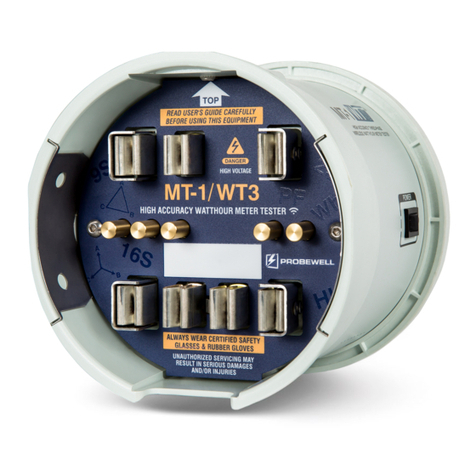
Probewell
Probewell MT-1/WT3 User manual

Probewell
Probewell ST-3/XT3 User manual
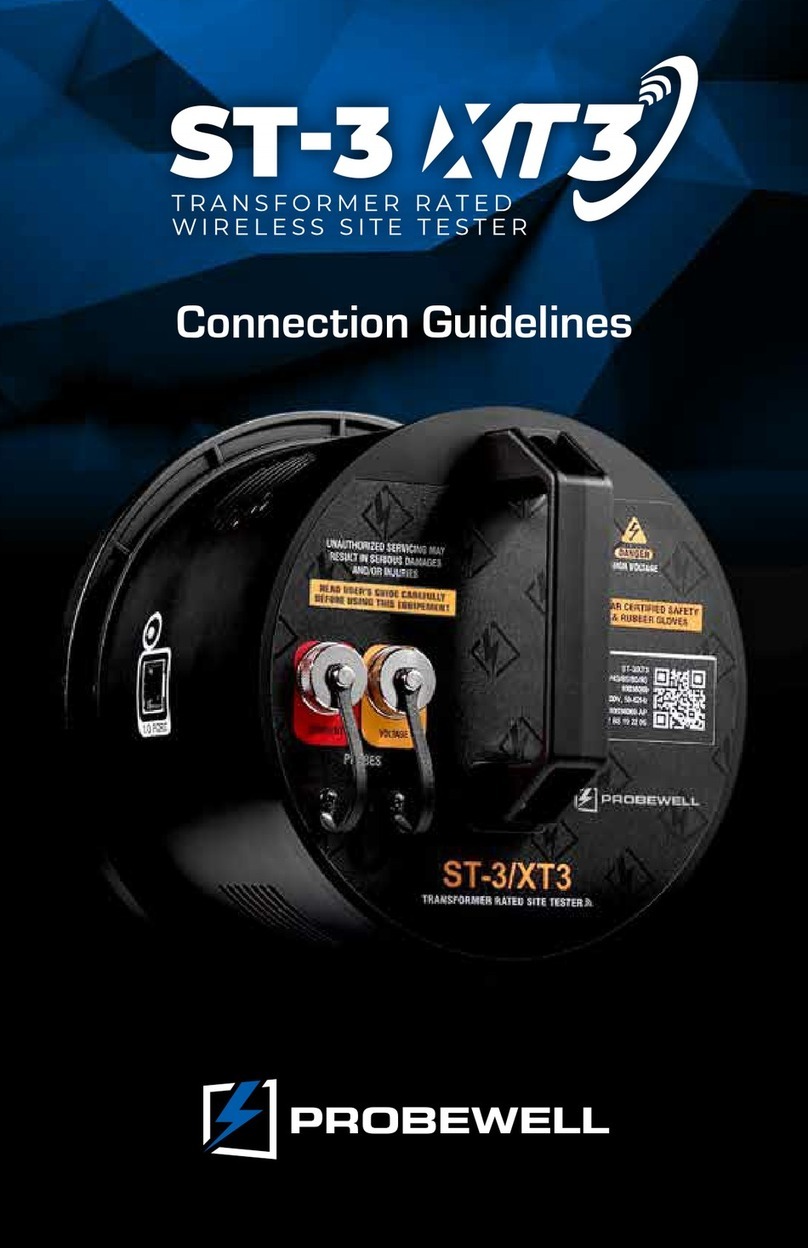
Probewell
Probewell ST-3/XT3 Instruction manual
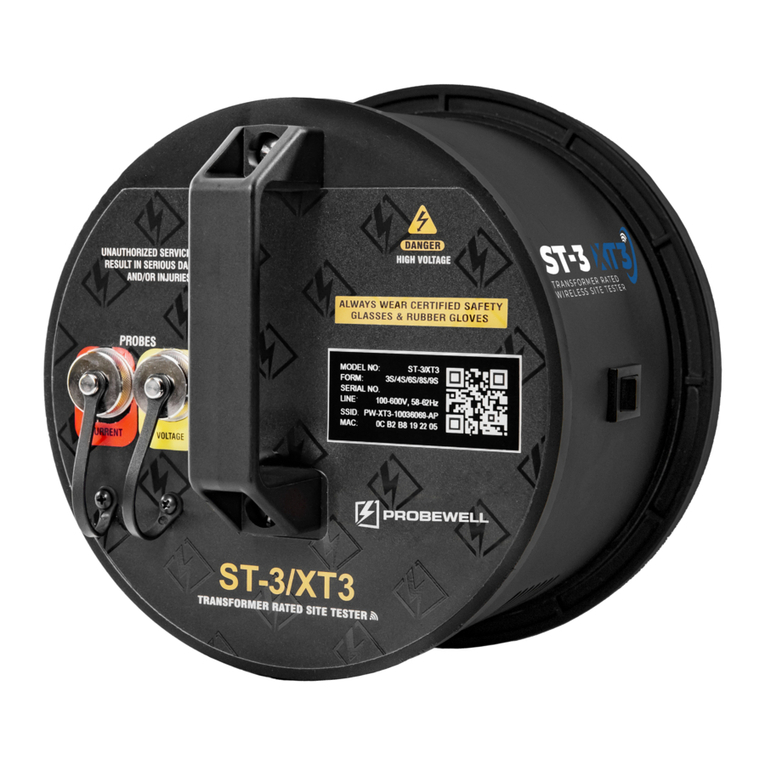
Probewell
Probewell ST-3 User manual
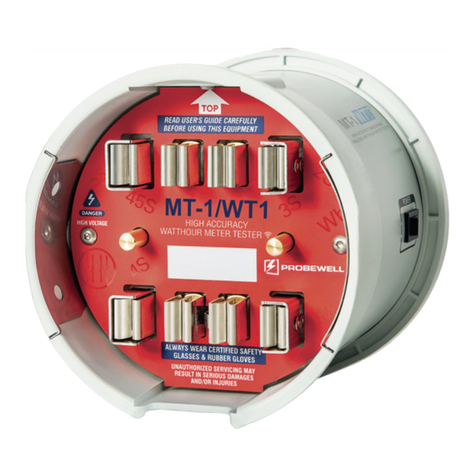
Probewell
Probewell MT-1/WT1 User manual

Probewell
Probewell ATK-3 User manual

Probewell
Probewell ST-3 Instruction Manual

Probewell
Probewell ST-3 User manual

Probewell
Probewell ST-3 User manual

